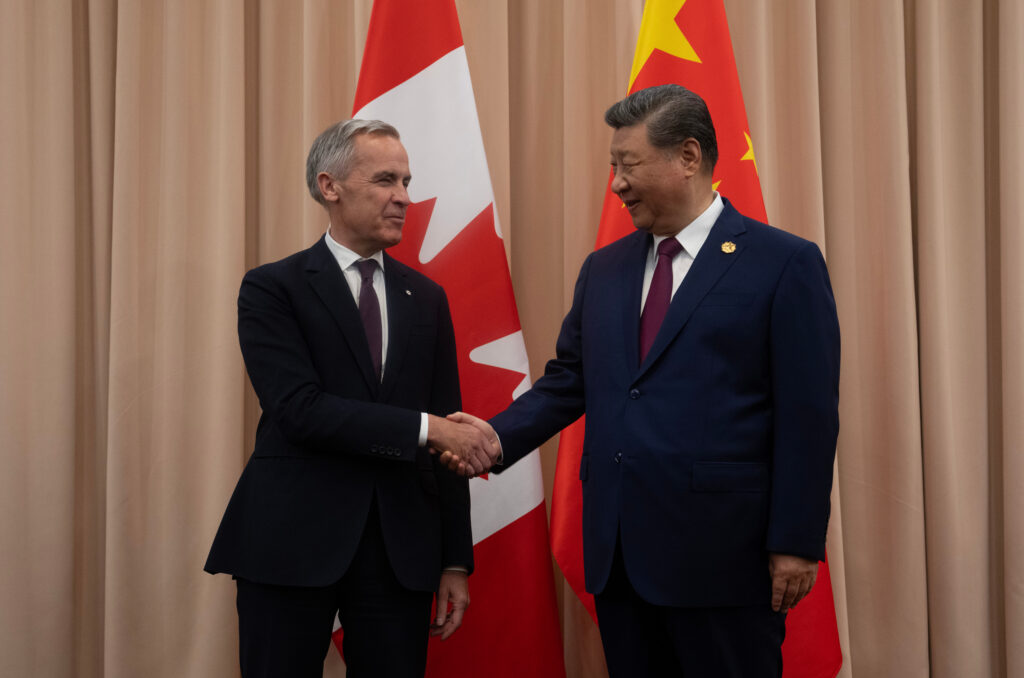TORONTO — The week after an anti-tariff ad funded by Ontario pushed President Donald Trump to halt trade talks with Canada, Prime Minister Mark Carney was having a far more cordial encounter with the unlikeliest of world leaders: Chinese President Xi Jinping.
Sino-Canadian ties cratered in 2018, when China detained two Canadians in what’s widely viewed here as hostage diplomacy. Canadian security officials have accused Beijing of espionage, interfering in elections and threatening critics here. China denies the claims. Both nations have expelled each other’s diplomats and put tariffs on each other’s goods.
But after this month’s meeting on the sidelines of the Asia-Pacific Economic Cooperation summit, the first between a Canadian prime minister and Chinese president since 2017, Carney heralded a “turning point.” Xi even invited him to China, and he RSVP’d in the affirmative.
The developments, which would have been improbable as recently as a year ago, are another indication of how Trump’s tariffs on Canadian goods and threats to make the country the 51st state are scrambling Ottawa’s economic and political alliances. Leaders here are now seeking to shift the economy from “reliance to resilience” by diversifying trade away from the United States, the destination for more than 75 percent of its exports. They’ve set a goal of doubling non-U.S. exports by 2035.
“The rules-based international order and the trading system that powered Canada’s prosperity for decades are being reshaped — threatening our sovereignty, our prosperity and our values,” the government says in its budget, unveiled this month. “In the process, we must redefine Canada’s international and security relationships. This is not a transition. It is a rupture.”
Carney won reelection in April by casting himself as the person best placed to manage that rupture. Now he’s eyeing a cautious rapprochement with not only China but also India and other nations with which Canada has had strained relations.
The approach, analysts say, holds potential and risks. Some warn Canada could be compromising its values by seeking to deepen ties with countries that don’t share them or that have previously weaponized dependence on their markets.
“Moving away from an unreliable America does not make China more reliable as a trading partner,” said Lynette Ong, director of the China Governance Lab at the University of Toronto’s Munk School of Global Affairs and Public Policy. “It’s about diversification of risks. It would be a mistake if we stop [trade diversification] at China … but since China is already our second trading partner, it is important to start there.”
There are signs that Canadian companies are looking to explore new markets, Export Development Canada says. The federal agency’s website traffic is up 61 percent this year, and visits to resources on trade diversification grew by 93 percent.
For decades, Canada’s foreign and economic policy has been based on seeking greater integration with the United States. U.S.-bound exports account for a fifth of Canada’s national income. For almost as long, critics have warned of the risks of relying so heavily on one market.
But diversifying markets has proved easier said than done, and business leaders acknowledge it will be difficult to entirely offset a decline in U.S. trade. Canada has more than a dozen free-trade agreements covering more than 50 countries, but most of its exports still go to its southern neighbor. China accounted for only 4 percent of exports in 2024.
Canada and the U.S. share the world’s longest undefended land border and a language. The large U.S. consumer market is a lure with which few options can compare. Accessing new markets can be difficult for small businesses with few resources to help navigate language and regulatory differences.
Carney’s budget earmarks billions of dollars for building infrastructure such as ports and airports to shuttle goods to new markets and more staff to facilitate trade missions.
“The measures that the government is taking now are the right kinds of measures,” said Gaphel Kongtsa, director of international policy at the Canadian Chamber of Commerce. “But it won’t be easy.”
The stakes are high. Trump’s tariffs are weighing on Canada’s export-driven economy. Canada’s exports fell 7 percent in August relative to the 2024 average, and exports to the U.S. dropped 10 percent. Regions most exposed to the levies are suffering job losses. GM and Stellantis recently announced plans to shift some production to the U.S.
“Trade friction means our economy will work less efficiently, with higher costs and less income,” Bank of Canada Governor Tiff Macklem told a parliamentary committee this month. “Even as economic growth recovers, the entire path for GDP is lower than it was before the shift in U.S. policy.”
Carney has sought a deal that would ease Trump’s tariffs, but talks are stalled. He apologized to Trump over the Ontario ad, which used audio from President Ronald Reagan in 1987 making a case against tariffs. Pete Hoekstra, the unpopular U.S. ambassador to Canada, berated an Ontario official over it in public last month and has called it foreign interference.
Since becoming prime minister, Carney has signed a trade deal with Indonesia and announced “energy corridors” to boost trade with Mexico. He traveled last week to the United Arab Emirates to begin trade talks.
His first international trip as prime minister was to Europe, where he touted Canada as “the most European of non-European countries.” Canadian and European officials have this year agreed to deepen trade ties and inked a deal that will allow Canada to sign on to Europe’s $173 billion rearmament and defense procurement plan.
Canada and Europe already have a free-trade agreement, which has been in place since 2017. Still, several E.U. member states have yet to ratify it. Mark Camilleri, chief executive of the Canada E.U. Trade and Investment Association, said there has been “a lack of ambition in promoting the Canada-E.U. relationship for a long time.”
A senior Canadian government official said Canada is eyeing an economic relationship with Europe similar to those of non-E.U. members Norway or Switzerland. The official spoke on the condition of anonymity to discuss the sensitive issue.
Javier Moreno Sánchez, chairman of the European Parliament’s delegation for relations with Canada, said, “It’s in our mutual interest to strengthen the relationship.”
“But we have to do it, not just say it,” he said. “We have to act now.”
More fraught is Canada’s pivot to the Indo-Pacific.
Carney’s predecessor, Prime Minister Justin Trudeau, came to office hoping to deepen ties with China. But those plans were quickly derailed.
In 2018, Beijing detained former Canadian diplomat Michael Kovrig and businessman Michael Spavor in apparent retaliation for Canada’s detention of a Chinese tech executive wanted in the U.S. on fraud charges. They were released in 2021, after the Huawei executive reached a deal with the U.S. Justice Department.
More recently, China imposed steep tariffs on Canadian agricultural goods in retaliation for levies that Trudeau imposed last year on Chinese-made electric vehicles. Canada imposed the tariffs to protect its electric vehicle industry and to align itself with the United States. The Chinese levies are hitting farmers in the prairie provinces hard.
In Canada’s Indo-Pacific Strategy, a document released last year, the Trudeau government called China an “increasingly disruptive global power” that is “looking to shape the international order into a more permissive environment for interests and values that increasingly depart from ours.”
Now, Canadian officials are calling it a strategic partner.
Carney has defended his efforts.
“This is the second-largest economy in the world,” he told reporters before meeting Xi. “This is one of the most influential actors in terms of the global system such as it is, and it is a country with whom we had no senior-level contact for seven years.”
There’s benefit for Xi, too.
“The slump in [China’s] economic growth and exports has not picked up to the pre-pandemic level,” Ong said. “In geopolitical terms, in the era of great power competition between the U.S. and China, it is logical that Beijing wants Ottawa, an important neighbor and ally of the U.S., on its side.”
Equally thorny are Canada’s efforts to repair ties with India.
The 2023 killing of a Sikh separatist in British Columbia was part of a broader campaign of violence against Indian dissidents here directed by senior intelligence and political officials in India, Canadian law enforcement officials say. They accuse India, too, of election interference. Both governments expelled each other’s diplomats and India suspended visa services in Canada.
Indian officials deny the allegations. But they also complain that the Canadian government coddles Sikhs who advocate for a separate homeland called Khalistan, a movement outlawed in India. Canada’s Sikh population, the largest Sikh community outside India, is an important voting bloc in many battleground electoral districts.
In a sign that Carney would take a different approach to India than his predecessor, he invited Indian Prime Minister Narendra Modi to a Group of Seven summit in the Canadian Rockies. Both countries have returned ambassadors, and on Sunday, they agreed to restart trade talks.
The Canadian official said Canada is open to aligning with countries that don’t share its values on certain issues in a more “pragmatic” approach to foreign policy. Canada “no longer [has] the luxury” of allowing domestic and diaspora politics to drive foreign policy, the official said, which has given Canada “more room to maneuver” with India.
Sikh advocacy groups in Canada have criticized the efforts while community members continue to face threats. Balpreet Singh, legal counsel for the World Sikh Organization of Canada, called the shift a “complete betrayal.”
“Our position is that Canada’s partnerships need to be based on respect for the rule of law and respect for our sovereignty,” he said. “But this relationship seems to be based pretty much on convenience.
“For us, accountability and security have to come before trade.”
The post Trump’s tariffs are pushing Canada closer to China and India appeared first on Washington Post.




